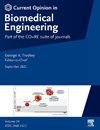肺纤维化进展中的机械传感途径
IF 4.2
3区 工程技术
Q2 ENGINEERING, BIOMEDICAL
引用次数: 0
摘要
纤维化疾病的特点是细胞外基质成分的过量产生,导致组织力学和功能的变化。假设在肺纤维化发病期间机械感知改变形成一个促进疾病进展的正反馈循环。然而,导致纤维化组织重塑而非稳态组织重塑的确切机制尚不清楚。创新的肺纤维化实验室模型的发展促进了病原力学传感的机制研究,并确定了新的抗纤维化候选物。这篇简短的综述将涵盖最近(5年)关于探索促进肺纤维化发展的机械转导途径和创新实验室模型的出版物,这些出版物可以推动该领域的发展。本文章由计算机程序翻译,如有差异,请以英文原文为准。
Mechanosensing pathways in the progression of pulmonary fibrosis
Fibrotic diseases are characterized by the excess production of extracellular matrix components that leads to changes in tissue mechanics and function. Mechanosensing altered during the onset of pulmonary fibrosis is hypothesized to form a positive-feedback loop that contributes to the progression of the disease. However, the exact mechanism(s) leading to fibrotic tissue remodeling as opposed to homeostatic tissue remodeling remains unknown. The development of innovative laboratory models of pulmonary fibrosis has facilitated mechanistic studies of pathogenic mechanosensing and identified new anti-fibrotic candidates. This brief review will cover recent (<5 years) publications that explore mechanotransduction pathways contributing to the development of pulmonary fibrosis and innovative laboratory models that can advance the field.
求助全文
通过发布文献求助,成功后即可免费获取论文全文。
去求助
来源期刊

Current Opinion in Biomedical Engineering
Medicine-Medicine (miscellaneous)
CiteScore
8.60
自引率
2.60%
发文量
59
 求助内容:
求助内容: 应助结果提醒方式:
应助结果提醒方式:


